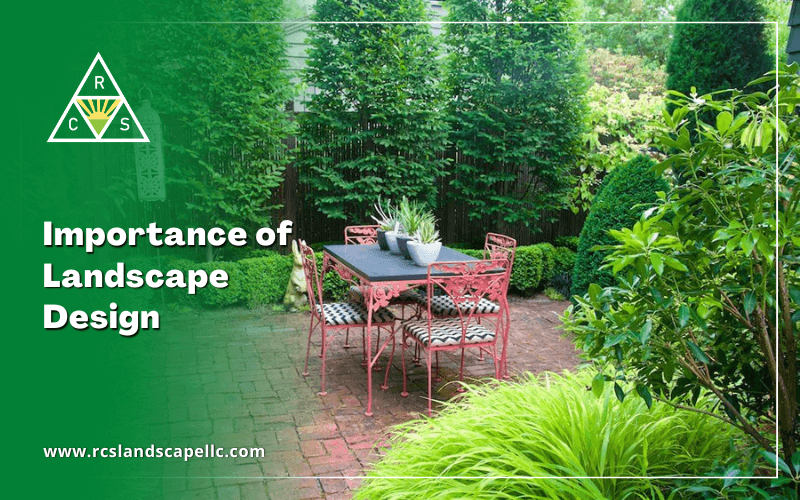The smart Trick of Landscape Design That Nobody is Discussing
Table of ContentsThe Ultimate Guide To Landscape DesignAn Unbiased View of Landscape DesignLandscape Design - TruthsThe Best Strategy To Use For Landscape Design
Official design motif. Credit: Gail Hansen, UF/IFAS The backyard is an expansion of the home where a variety of tasks take place. A lawn can normally be split into 3 locations: public (the front backyard), personal (the back backyard), and solution (commonly the side lawn). The place of activity areas depends primarily on the kind of location, the size of room required, the sort of task, and the wanted closeness to other activities and structures (Landscape Design).
The outside wall of your house frequently works as the first wall surface or starting point of an exterior space. Incompatible uses ought to be separated, and related activities, such as cooking and dining, need to be assembled to make the yard extra reliable and pleasurable. When making use of hardscape to produce rooms, make use of building material similar to that made use of in your house for continuity from your home into the garden.
Connected areas. Credit: Gail Hansen, UF/IFAS Using similar hardscape features and duplicating plants draws the eye around the yard. Essential factors along the method can be emphasized with plantings or functions that draw focus and urge activity in a certain instructions. Relocating along the course takes a person from one area to the next and enables the individual to have a variety of experiences.
From a design point of view, plant products have three significant functions in the landscape: aesthetic, architectural and utilitarian. Aesthetically, plants produce a visually pleasant atmosphere and structurally plants organize and define spaces.
9 Easy Facts About Landscape Design Described
For psychological comfort plants are utilized as physical or suggested barriers for personal privacy and safety and security. Physical obstacles block both the sight and accessibility to a space and include fencings, walls and plant hedges.
Physical and implied obstacles. Debt: Gail Hansen, UF/IFAS For these reasons, the sorts of plants to be utilized (such as trees, bushes, or groundcovers) should be selected in the early stages of planning. Plant types are selected for their functional capabilities to ensure that their future purpose and called for space can be considered at the very same time.
The overhead airplane, the upright airplane and the ground aircraft ought to all be taken into consideration to produce unit. Once the form of a plant bed has been developed, the plants must be massed (grouped) and layered to accomplish visual unity and the wanted amount of unit. The dimension of a plant mass will certainly depend upon the total size of the backyard, the size of the private plants in the mass, and the emphasis or influence desired from the plant material.
Each plant mass remains in front of, behind, or beside, an additional mass. Figure 11. see here now Straight plant layers. Credit History: Gail Hansen, UF/IFAS Number 12. Vertical plant layers. Credit Score: Gail Hansen, UF/IFAS Repeating plants within a mass and repeating masses with similar plants links the garden with each other. The specific plant characteristics should be considered to efficiently layer and mass plants.
The 8-Minute Rule for Landscape Design
All plant make-ups start with the major framework plants, the big, mainly evergreen history plants-such as the trees and large shrubs. These plants different or enframe rooms, manage the size of the room, and supply the starting point for picking the suitable features of the 2nd layer, midground plants, for massing and infill.
Essential factors in the yard ought to be highlighted by the usage of unique plants, distinctive structures, or yard ornaments. Noting thresholds or entrances to rooms can be done with gates, arbors, and steps, or through making use of unique and colorful plants. The form and/or style theme of the yard will often aid establish the important factors and exactly how they ought to be highlighted.
Various other vital places in the backyard are centerpieces, which is used to visually arrange a landscaped location. The type of centerpiece frequently relies on the checking out point of view. Different viewpoints or viewpoints can disclose various structures in the landscape that may need a selection of focal points. Contrasting appearance, form, size and color will Read More Here catch and hold the eye.
How Landscape Design can Save You Time, Stress, and Money.
Figure 13. Plant forms. Credit Scores: Gail Hansen, UF/IFAS After type, texture is the next dominant function of a plant; crude, tool and fine structures can be made use of for comparison and focus in the landscape. Kind and structure both trump shade in the garden for a lot of the year. Nevertheless, during certain periods, shade will be one of the most recognizable feature of the garden.


The pleasurable aroma of plants, the sound of wind in the trees, the audio and texture of water, and the shades and structures of sculptures, pots and garden furniture all contribute to the experience of the yard. One detail that is often ignored is the effect of light on the aesthetics of the plants.
The entire garden adjustments in function and appearance over the course of the day, and the program of a year, as the light and temperature adjustment from morning to night and period to period. Plant selection must take into consideration a plant's growth rate, its fully grown dimension and type, and the upkeep it will need.
It is very important to understand the ultimate mature dimension of plants so they can be placed in the right click for more place and spaced properly when they are set up. Giving plants space to expand is a challenge since the usual mature dimension is usually based upon optimal growing problems and the ecological problems of a site might trigger a plant to enlarge or stay smaller sized.